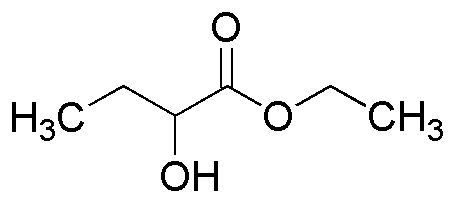2-Hydroxy-N-butyric acid ethyl ester is widely utilized in research focused on:
- Flavoring and Fragrance Industry: This compound is used as a flavoring agent in food products and beverages, providing a fruity taste that enhances consumer appeal.
- Pharmaceuticals: It serves as an intermediate in the synthesis of various pharmaceuticals, contributing to the development of medications with improved efficacy.
- Cosmetics: The compound is incorporated into cosmetic formulations for its moisturizing properties, helping to improve skin texture and hydration.
- Agricultural Chemicals: It is utilized in the production of agrochemicals, enhancing the effectiveness of pesticides and herbicides, which can lead to better crop yields.
- Research Applications: In academic and industrial research, it is used as a reagent in organic synthesis, aiding in the development of new chemical compounds with potential applications across various fields.
General Information
Properties
Safety and Regulations
Applications
2-Hydroxy-N-butyric acid ethyl ester is widely utilized in research focused on:
- Flavoring and Fragrance Industry: This compound is used as a flavoring agent in food products and beverages, providing a fruity taste that enhances consumer appeal.
- Pharmaceuticals: It serves as an intermediate in the synthesis of various pharmaceuticals, contributing to the development of medications with improved efficacy.
- Cosmetics: The compound is incorporated into cosmetic formulations for its moisturizing properties, helping to improve skin texture and hydration.
- Agricultural Chemicals: It is utilized in the production of agrochemicals, enhancing the effectiveness of pesticides and herbicides, which can lead to better crop yields.
- Research Applications: In academic and industrial research, it is used as a reagent in organic synthesis, aiding in the development of new chemical compounds with potential applications across various fields.
Documents
Safety Data Sheets (SDS)
The SDS provides comprehensive safety information on handling, storage, and disposal of the product.
Product Specification (PS)
The PS provides a comprehensive breakdown of the product’s properties, including chemical composition, physical state, purity, and storage requirements. It also details acceptable quality ranges and the product's intended applications.
Certificates of Analysis (COA)
Search for Certificates of Analysis (COA) by entering the products Lot Number. Lot and Batch Numbers can be found on a product’s label following the words ‘Lot’ or ‘Batch’.
*Catalog Number
*Lot Number
Certificates Of Origin (COO)
This COO confirms the country where the product was manufactured, and also details the materials and components used in it and whether it is derived from natural, synthetic, or other specific sources. This certificate may be required for customs, trade, and regulatory compliance.
*Catalog Number
*Lot Number
Safety Data Sheets (SDS)
The SDS provides comprehensive safety information on handling, storage, and disposal of the product.
DownloadProduct Specification (PS)
The PS provides a comprehensive breakdown of the product’s properties, including chemical composition, physical state, purity, and storage requirements. It also details acceptable quality ranges and the product's intended applications.
DownloadCertificates of Analysis (COA)
Search for Certificates of Analysis (COA) by entering the products Lot Number. Lot and Batch Numbers can be found on a product’s label following the words ‘Lot’ or ‘Batch’.
*Catalog Number
*Lot Number
Certificates Of Origin (COO)
This COO confirms the country where the product was manufactured, and also details the materials and components used in it and whether it is derived from natural, synthetic, or other specific sources. This certificate may be required for customs, trade, and regulatory compliance.


